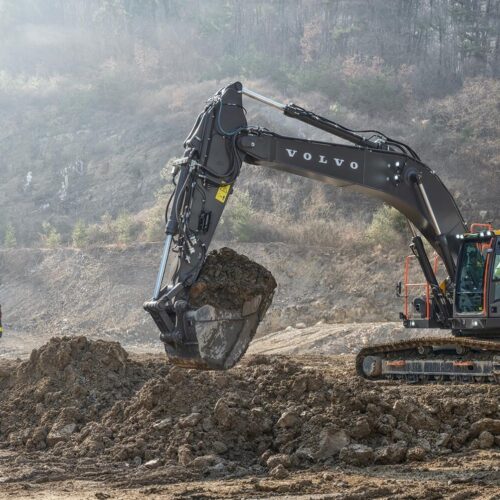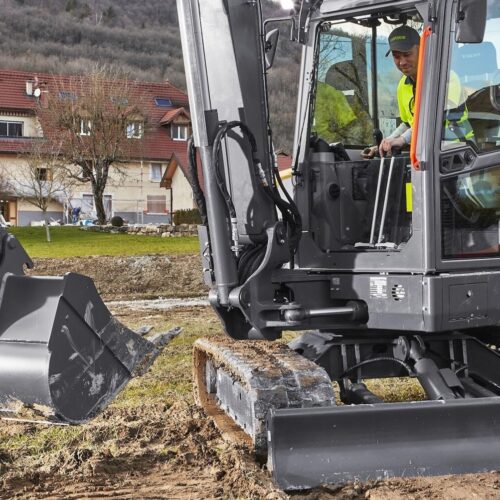How Lithium Batteries Work
Many people in the construction industry understand the basics of how internal combustion engines work — but what about the batteries used to power electric construction equipment? Now’s a great […]


Many people in the construction industry understand the basics of how internal combustion engines work — but what about the batteries used to power electric construction equipment? Now’s a great time to learn since battery-electric machines are becoming more common on jobsites.
Most electric vehicles — like cars and Volvo electric machines — use lithium-ion batteries, which are rechargeable batteries also used in electronic devices such as mobile phones, laptops and more. They’re called “lithium-ion” because lithium ions move between two electrodes during the charging and discharging cycles to store and release energy.
Let’s take a deeper look at what makes up a lithium-ion battery and how the components inside work.
THE COMPONENTS OF A LITHIUM-ION BATTERY
First off, electricity can’t be captured and stored. It must be converted into another energy form (e.g chemical energy) which can then be stored.
Batteries are like fuel tanks — they don’t produce energy, but rather store it. In an internal combustion engine, the bond energies within gasoline or diesel molecules are broken and converted to heat, which in turn transforms into the mechanical energy needed to drive the piston inside the engine. Similarly, batteries store electricity from the power grid in the form of chemical potential and then discharge that energy to provide electricity when it’s needed.
Lithium-ion batteries contain four major components:
1. Anode (-)
2. Cathode (+)
3. Electrolyte
4. Separator
A battery must be connected to an external circuit (e.g. an electric machine or a mobile phone, as examples) to absorb and release energy. Electrons are the energy that provide the power. They move from the anode through the external circuit to the cathode while lithium ions stay inside the battery and move through the electrolyte to the other side — we’ll explain this more in a bit.

First, what are anodes, cathodes, separators and electrolytes? Let’s take a look:
- The anode (the negative end) is the “giver” in the battery. It releases or “gives” electrons and lithium ions to the cathode during discharge, and then it takes them back during charging. Anodes are typically made of carbon graphite because it arranges and stores lithium in an optimized state.
- The cathode (the positive end) is the “receiver” of the battery. It receives lithium ions during discharge, and then releases them during charging. Cathodes are typically made of metal-oxides [e.g., NMC (nickel, manganese and cobalt oxide), NCA (nickel, cobalt and aluminum) or LFP (lithium, iron and phosphate)] that want to take on available electrons.
- The electrolyte is a chemical solution (e.g. a liquid) between the anode and cathode that allows lithium ions to transfer back and forth between the anode and cathode.
- The separator is non-conductive, semipermeable and divides the anode and cathode. It allows only lithium-ions to pass through — it prevents electrons from doing the same. The electrons take a different path to the other side (through the external circuit that powers a machine or device). This selective permeability is crucial for the battery’s function and safety, as it prevents short circuits and ensures efficient energy storage and release.
- Note: The separator is what keeps the chemical reactions inside a lithium-ion battery from getting out of control. This is why you’re always asked not to check lithium batteries on a plane.
WHY LITHIUM IS USED IN MOST RECHARGEABLE BATTERIES
Lithium is popular because it’s incredibly reactive and can store a lot of energy. This reactivity allows lithium-ion batteries to be small and lightweight, yet powerful — which is ideal for portable electronics and electric vehicles.
On the periodic table of elements, you’ll notice that Lithium is #3, meaning it has three protons (+) in its nucleus and three electrons (-) arranged in two “shells” around the nucleus — this electron arrangement is the key.

The first shell holds two electrons — further out, the second shell holds one. This single electron in the outer shell makes lithium highly reactive, as it wants to lose this electron to achieve a more stable configuration.
When lithium loses its electron, the remaining subatomic particles become what’s called an ion. An ion is simply an atom that has an electric charge because it either gained electrons, making it negatively charged, or lost electrons, making it positively charged. In this case, lithium loses an electron and becomes a positively charged lithium ion. This is where lithium-ion batteries get their name.
So, where do these lost electrons and newly formed lithium ions go?
HOW LITHIUM-ION BATTERIES WORK
To explain what’s happening, we’ll use the NMC (nickel, manganese and cobalt oxide) battery configuration on an electric machine as our example:
- To start, a battery is fully charged and not connected to a machine. The transfer of molecules that creates energy from the anode to the cathode cannot begin until they’re connected via a circuit — in this case, when the battery is turned on and the machine is being used.
- While the battery is discharging during use, lithium ions move from the anode (negative side) to the cathode — remember, the cathode wants electrons, and the lithium in the anode wants to give them up. This flow of electrons from the anode to the cathode is forced through the circuitry of the machine to power it. The electrons facilitate the transfer of energy from the battery to the machine, but they themselves do not get consumed.
- To help bring electrons over to the cathode, a conductive aluminum layer is added to this side.
- The electrons moving to the positive side of the battery start to build up a negative charge in the cathode — and electrons, which are negative, don’t like to move toward a negative environment. Remember, opposites attract — so to keep the reaction going, the anode simultaneously releases positive lithium ions to the cathode through the electrolyte inside the battery.
Once most of the lithium has moved from the anode to the cathode during discharge, the battery is empty.
DISCHARGING: LITHIUM IONS & ELECTRONS MOVE FROM ANODE TO CATHODE
CHARGING: LITHIUM IONS & ELECTRONS MOVE FROM CATHODE TO ANODE
- Then, when you plug the machine into an external power source to recharge it, the electrons on the cathode side are forced back to the anode side where they started. And as a result, the lithium ions once again pass through the electrolyte and separator back to the anode to produce a balanced system. What happens during machine charging is simply the opposite of what happens during discharging.
- To help bring electrons back to the anode, a conductive copper layer is added to this side.
- These opposite reactions are what make lithium-ion batteries rechargeable.
Over time, though, the irreversible nature of the process can change the chemistry and structure of battery materials, which, in turn, can reduce battery life and performance.
WHY WE USE NMC LITHIUM-ION BATTERIES AT VOLVO
It’s worth noting too that different types of lithium-ion batteries have slightly different chemistries. Still, they all rely on the movement of electrons and lithium ions between electrodes to store and release energy.
The most common types of batteries are lead acid, nickel based and lithium-ion — and there are a few different kinds of lithium-ion batteries based on the material they’re made from. Here at Volvo, we’re currently using NMC (nickel, manganese, cobalt oxide) because they:
- have the most technological maturity
- are currently the easiest to manufacture
- have high energy density
- provide a long battery lifecycle
- are a safer option compared to some other configurations
- can be recycled
Lithium-ion batteries are superior to lead-acid batteries because they:
- have triple the energy density
- provide double the battery life
- consistently outperform in high-temperature applications
- charge quickly
- have no memory effect and no maintenance
Among lithium-ion batteries, NMC has better fast-charging capabilities, better cold-weather performance and a higher energy density when compared with LFP.
CHARGING TIPS FOR LITHIUM-ION BATTERIES IN ELECTRIC CONSTRUCTION EQUIPMENT
If you own electric heavy equipment, here are a few tips to help ensure you have plenty of power when you need it and limit battery degradation over time:
- Keep the electric machine at around 90% State of Charge and refrain from charging up to 100% too often.
- Avoid allowing the battery to get too low. If you can, don’t let your battery run down to 0%.
- If you aren’t going to use your electric machine for an extended period, keep it around 40-50% charged (a fully charged battery has a higher self-discharge rate).
- Try to use an AC slow charger at least once a week and let the battery management system (BMS) balance the battery packs.
- Pre-condition your machine, particularly during cold winter months. This may involve warming up the battery pack or machine to an appropriate temperature range to enhance the efficiency of the charging process. By preconditioning, the battery’s internal temperature is brought to an ideal level, allowing for more effective charging and potentially extending overall battery life.

Note that for Volvo electric equipment, the SOC window is between 10% and 90%, versus for cars where the SOC window is wider. An electric machine showing 0% SOC is actually 10% for the battery and showing 100% SOC is actually 90%.
We recognize this all may still seem a bit complicated, but a big part of that is because it’s still fairly new to our industry. Think about how confusing it can be for someone new to learn about how an internal combustion engine works. With time and experience, though, it all starts to make more sense — and this will too.
If you’re interested in seeing how electric machines perform, reach out to your local Volvo dealer. They can work with you or even operate a machine so you can better understand how they offer the same power and performance as comparable diesel models.
Categories: Corporate Information, Electric Equipment

